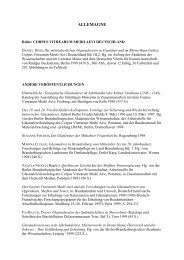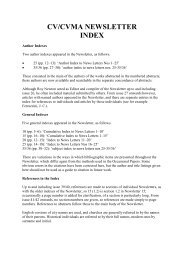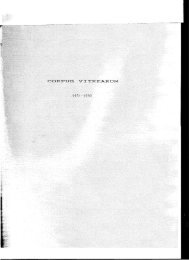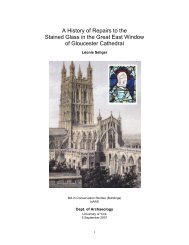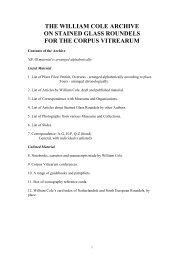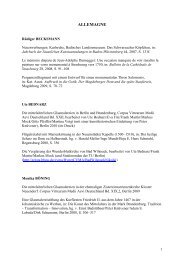BristolConference - Corpus Vitrearum Medii Aevi
BristolConference - Corpus Vitrearum Medii Aevi
BristolConference - Corpus Vitrearum Medii Aevi
You also want an ePaper? Increase the reach of your titles
YUMPU automatically turns print PDFs into web optimized ePapers that Google loves.
"<br />
1501-1502. Besides what is probably the<br />
finest collection of 15 th -century glass outside<br />
York Minster, Malvern retains an unparalleled<br />
collection of medieval tiles, as well as choir<br />
stalls with 14thand 15 th -century misericords.<br />
By the 18 th century the church was dilapidated<br />
and its glass in a shocking state. The response,<br />
in 1802,was a plan to tidy up what remained<br />
by a wholesale movement of panels to fill the<br />
gaps, mainly from the nave to the eastern parts<br />
of the church. Despite vigorous protests, this<br />
misguided and disastrous scheme was set in<br />
motion in 1812. Further restoration took place<br />
under Gilbert Scott in 1861, before careful<br />
repairs were carried out from 1909by Kempe<br />
& Co. Some glass has been releaded recently<br />
by Hardman and John Baker, but nothing has<br />
come of discussions on protective glazing.<br />
Many panels have been lost or moved and<br />
an understanding of the original layout,<br />
patronage and dating depends on antiquarian<br />
sources, like Thomas Habington's 'Survey<br />
of Worcestershire' (c. 1605-47) and William<br />
Thomas's Antiquitates Prioratus Majoris<br />
Malverne (1725). Conclusions were presented,<br />
along with a brilliant study of the iconography,<br />
by G. MeN. Rushforth in his Medieval Christian<br />
Imagery as illustrated by the Painted Windows in<br />
Great Malvern Priory Church, Worcestershire<br />
(1936).<br />
East Window and Choir Clerestory (I,<br />
NII-NIV, SII-SIV)<br />
The iconography of the glazing followed a<br />
broadly definable scheme in which the east end<br />
of the choir was used for the early life of the<br />
Virgin, and Christ's Incarnation and Passion. A<br />
pair of windows (NIl, SII) given by Prior John<br />
Malvern (£1.1435)and other monks, dealt with<br />
the first two themes, although nothing survives<br />
of the Nativity and Adoration once in SIl,which<br />
now contains tracery panels from the nave.<br />
The impressive east window (I) depicts the<br />
Passion and Resurrection, from Christ's Entry<br />
into Jerusalem to Pentecost. The tracery lights,<br />
with Apostles, saints and angels, are well<br />
preserved, but many main-light panels are<br />
broken or replaced by intruded glass from the<br />
choir aisles and clerestory, particularly on the<br />
right. Well preserved panels like the Entry<br />
into Jerusalem or the Last Supper confirm the<br />
quality of the glass, which is typical of English<br />
International Gothic in colour, style and<br />
design. Comparisons have been made with<br />
the St William Window at York (c.1415) and<br />
glass, closer to hand, from Hereford and Rosson-Wye,<br />
windows perhaps to be associated<br />
with John Thornton of Coventry, active in the<br />
Midlands and York at this time. Connections<br />
with manuscripts like the Hours of Elizabeth<br />
the Queen (c.1420-30) are tantalizing, as the<br />
latter was owned by the Beauchamp Earls of<br />
Warwick who were overlords of Malvern and<br />
benefactors of the Priory. Their arms, once<br />
carved at the apex of the window and<br />
dateable to 1423-39, may provide a dating for<br />
the glass.<br />
The glazing of the other two windows in the<br />
north choir clerestory is still in situ. The first<br />
(NIII) proclaims bishop saints of the Worcester<br />
diocese, and includes Wulstan, the supposed<br />
founder of the Priory, along with St Anne and<br />
the Virgin, who regularly appear in the<br />
Malvern glass. Some donor panels of citizens of<br />
Worcester and monks (mentioned in<br />
documents of the 1420sand 1430s)are now in<br />
the east window. Continuing the historical<br />
theme and of particular interest is the Founders<br />
Window (NIV) of c.1440-50.This illustrates the<br />
founding of St Werstan's hermitage at Malvern,<br />
his martyrdom at the hands of the Danes, the<br />
founding of the Priory in the reign of Edward<br />
the Confessor and subsequent charters and<br />
donations granted by William the Conqueror<br />
and others. Armorials in the tracery stress<br />
Malvern's links with the Confessor and<br />
Westminster.<br />
Two windows opposite (Sill, SIV) originally<br />
contained the Apostles Creed and saints, but<br />
little remains in situ. Note in the first window<br />
an extended Crucifixion and in both windows<br />
figures from a series of the Nine Orders of<br />
Angels, all originally in the north nave<br />
clerestory. St Michael was one of the patron<br />
saints of Malvern.<br />
North Choir Aisle (nIl-nV)<br />
The windows in this aisle were mainly given by<br />
local families during the first half of the 15 th<br />
century. They were used to reinforce orthodox<br />
Christian teaching and included subjects<br />
frequently found in parish churches: the Mass,<br />
Doctors of the Church, Seven Sacraments, Ten<br />
Commandments and Lord's Prayer. Little,<br />
apart from the canopies and tracery lights,<br />
remains in place, but Rushforth identified<br />
fragments from most of the windows in the<br />
great east window. The Museum Window (nV)<br />
retains its tracery lights with the Infancy of<br />
Mary and Christ. Originally this was a Creed<br />
window with prophets, Apostles and, perhaps<br />
under the influence of German block-books,<br />
pictorial representations of each article in the<br />
Creed. It now contains an interesting collection<br />
of fragments.<br />
31



